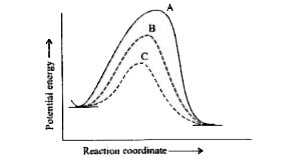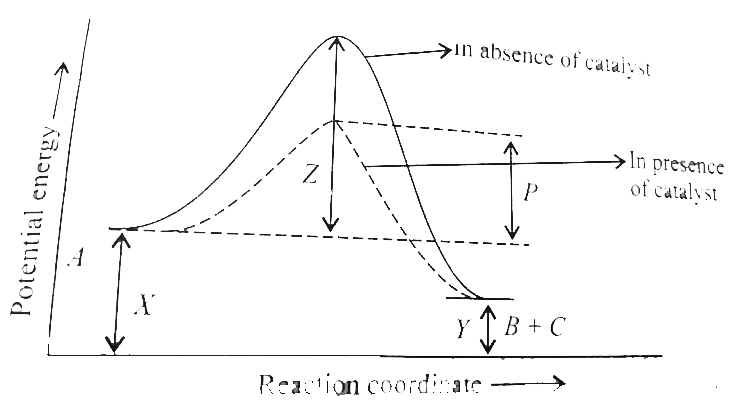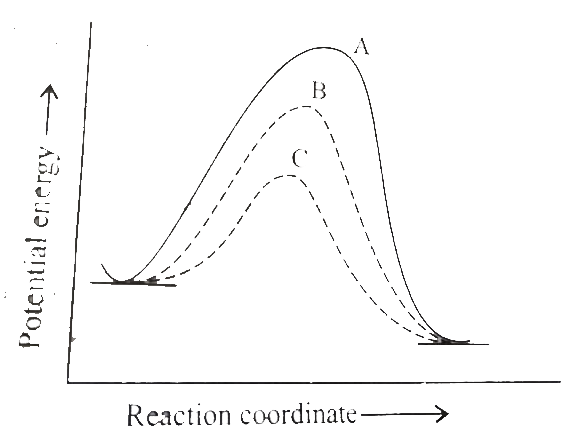Substances which alter the velocity of a reaction by mere presence, without undergoing any change in mass and composition are termed catalysts and the phenomenon is known as catalysis.
In homogenous catalytic reactions, there are three alternative paths A, B and C (shown in figure). Which one of the following indicates the relative case with which the reaction can take place?
 Solution in Malayalam
Solution in Malayalam
A>B>C
C>B>A
B>C>A
A=B=C
The correct Answer is:B
Activation energy in the different path lies in the following sequence:
C<B<A
Lesser is the activation energy, greater is the case with which the reaction can take place.
∴C>B>A (Decreasing ease with which the reaction can take place.)
Similar Questions
Read the given passage and answer the questions
A substance which alters the rate of chemical reaction without undergoing any change in mass and chemical composition at the end of reaction is called catalyst. It may be noted that catalyst which increases the speed of a reaction is called positive catalyst and catalyst which decrease the speed of reaction is called negative catalyst. The promoters are substances that enhance the activity of catalyst and poisons are the substances which decrease the activity of catalyts.
What are poisons ?02:03View SolutionRead the given passage and answer the questions
A substance which alters the rate of chemical reaction without undergoing any change in mass and chemical composition at the end of reaction is called catalyst. It may be noted that catalyst which increases the speed of a reaction is called positive catalyst and catalyst which decrease the speed of reaction is called negative catalyst. The promoters are substances that enhance the activity of catalyst and poisons are the substances which decrease the activity of catalyts.
How many types of catalysts are there ?02:36View SolutionRead the given passage and answer the questions
A substance which alters the rate of chemical reaction without undergoing any change in mass and chemical composition at the end of reaction is called catalyst. It may be noted that catalyst which increases the speed of a reaction is called positive catalyst and catalyst which decrease the speed of reaction is called negative catalyst. The promoters are substances that enhance the activity of catalyst and poisons are the substances which decrease the activity of catalyts.
What are a positive catalysts ?02:51View SolutionRead the given passage and answer the questions
A substance which alters the rate of chemical reaction without undergoing any change in mass and chemical composition at the end of reaction is called catalyst. It may be noted that catalyst which increases the speed of a reaction is called positive catalyst and catalyst which decrease the speed of reaction is called negative catalyst. The promoters are substances that enhance the activity of catalyst and poisons are the substances which decrease the activity of catalyts.
What are promoters ?04:49View SolutionSubstances which alter the velocity of a reaction by mere presence, without undergoing any change in mass and compossition are termed catalyst and the phenomenon is known as catalysis According to the adsorption theroy of catalysis, the rate of reaction increases because
06:49View SolutionSubstances which alter the velocity of a reaction by mere presence, without undergoing any change in mass and compossition are termed catalyst and the phenomenon is known as catalysis
For the reaction (A→B+C) , the energy profile diagram is given in the figure below.

The decrease in the energy of activation in the presence of catalyst is01:38View SolutionSubstances which alter the velocity of a reaction by mere presence, without undergoing any change in mass and compossition are termed catalyst and the phenomenon is known as catalysis
In homogenous catalytic reactions, there are three alternative paths A, B, and C (shown in figure). Which one of the following indicates the relative ease with which the reaction can take place?
 02:32View Solution
02:32View SolutionSubstances which alter the velocity of a reaction by mere presence, without undergoing any change in mass and compossition are termed catalyst and the phenomenon is known as catalysis Which is incorrect for a catalyst?
04:42View Solution

